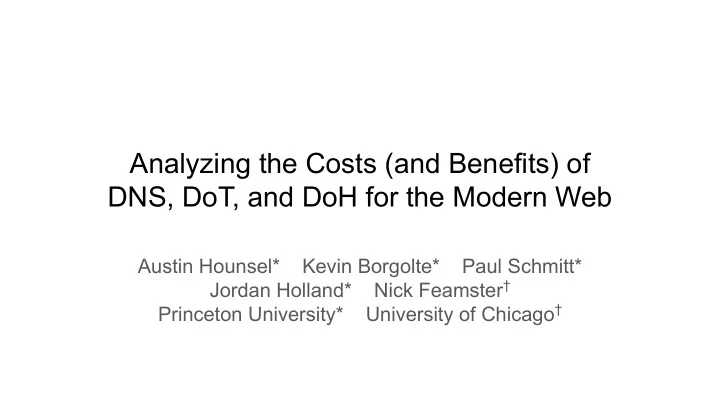

Analyzing the Costs (and Benefits) of DNS, DoT, and DoH for the Modern Web Austin Hounsel* Kevin Borgolte* Paul Schmitt* Jordan Holland* Nick Feamster † Princeton University* University of Chicago †
DNS Privacy Has Become a Significant Concern ● On-path network observers can spy on and tamper with DNS traffic (Do53) ● Two protocols have been proposed to encrypt DNS traffic ○ DNS-over-TLS (DoT): RFC 7858 ○ DNS-over-HTTPS (DoH): RFC 8484 2 https://arxiv.org/abs/1907.08089
Contributions ● Extensive performance study of Do53, DoT, and DoH ● Insights to optimize DNS performance 3 https://arxiv.org/abs/1907.08089
Experiment Overview ● Goal: Understand how Do53, DoT, and DoH affect user experience ○ Query response times ○ Page load times ○ Effect of changing network conditions 4 https://arxiv.org/abs/1907.08089
5
Response Times from Cloudflare on Princeton’s Network 6 https://arxiv.org/abs/1907.08089
Response Times from Google on Princeton’s Network 7 https://arxiv.org/abs/1907.08089
Response Times from Quad9 on Princeton’s Network 8 https://arxiv.org/abs/1907.08089
Takeaway: DoH Can Outperform Do53 ● DoH outperforms Do53 in the tail of response times ○ Caching of DNS wire format? ● This result supports Mozilla’s findings 9 https://arxiv.org/abs/1907.08089
Measuring Page Load Time ● We measured page load times to understand user experience ● For this talk, we’re only focusing on Cloudflare ○ Fastest response times 10 https://arxiv.org/abs/1907.08089
Measuring Page Load Time ● We also performed traffic shaping ○ Princeton’s network was the baseline ○ 4G: 53.3ms additional latency, 1ms jitter, 0.5% loss ○ Lossy 4G: 53.3ms additional latency, 1ms jitter, 1.5% loss ○ 3G: 150ms additional latency, 8ms jitter, 2.5% loss 11 https://arxiv.org/abs/1907.08089
Page Loads with Cloudflare on Princeton’s Network 12 https://arxiv.org/abs/1907.08089
Page Loads with Cloudflare on Emulated 4G Network 13 https://arxiv.org/abs/1907.08089
Page Loads with Cloudflare on Emulated, Lossy 4G Network 14 https://arxiv.org/abs/1907.08089
Page Loads with Cloudflare on Emulated 3G Network 15 https://arxiv.org/abs/1907.08089
Takeaway: DNS-over-TCP Can Help Page Load Times ● TCP packets can be retransmitted as soon as two round-trips ● This helps DoT/DoH perform well on lossy networks ● Timeout for Do53 implementations might be higher 16 https://arxiv.org/abs/1907.08089
Potential Improvements for Do53, DoT, and DoH ● Opportunistic partial responses ● Wire format caching ● HTTP/2 push for DoH 17 https://arxiv.org/abs/1907.08089
Conclusion ● DoT performs better than DoH, and sometimes better than Do53 ● DoH has potential! ● Choice of recursor & network matter ● Transport characteristics of TCP should be explored Check out the full pre-print: https://arxiv.org/abs/1907.08089 18
Recommend
More recommend